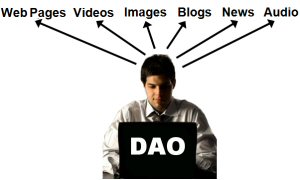 Thank you to Jonathan Dingman, who writes the Google News, Inside blog, for attending the DPAC II conference in New York this week and blogging the session, “SEO: Is Finding Your Inner DAO the Answer?” which included: Ron Belanger, Vice President, Agency Development at Yahoo!, Anne Kennedy, Managing Partner at Beyond Ink, Jolina Pettice, Senior Account Manager at TopRank Online Marketing and Noah Elkin, Vice President of Corporate Strategy at Steak as moderator.
Thank you to Jonathan Dingman, who writes the Google News, Inside blog, for attending the DPAC II conference in New York this week and blogging the session, “SEO: Is Finding Your Inner DAO the Answer?” which included: Ron Belanger, Vice President, Agency Development at Yahoo!, Anne Kennedy, Managing Partner at Beyond Ink, Jolina Pettice, Senior Account Manager at TopRank Online Marketing and Noah Elkin, Vice President of Corporate Strategy at Steak as moderator.
Digital Asset Optimization (DAO) is something that any publisher, of any kind, ought to be doing on a regular basis. Alright, so if you should be doing it, what exactly is DAO?
DAO is, essentially, optimizing what you own as an asset, digitally. It’s pretty straight forward. Whether it’s a video, an image, presentation, or a podcast, as a few examples, those are your digital assets. A video is an asset which should be optimized for maximum exposure.
Ron Belanger from Yahoo pointed out that the search engine results page (SERP) returned when searchers enter a query is changing to destination rather than a “get it done”” page. This involves bringing in images, videos and links. Making things kinds of changes resulted in click through rates going up 30% just by changing the layout of the page. The whole market is embracing the change of the SERP.
Jolina Pettice of TopRank Online Marketing talked about how you ought to be optimizing your digital assets from the get-go. Videos, for example, should be optimized from the point they are produced to the point where they are published. Meta keywords, embedding the video within content that is relevant, and distributing the video, are all great ways to draw traffic to your video. Which, in turn, will draw traffic to your site and/or company.
It is very important to train and inform your staff about optimizing these assets. Going back to videos, train your staff how to optimize your videos so you never have to retro-actively have to go back and optimize them after they’re already been published. No one has the time to go back and optimize hundreds or thousands of videos or assets after they’ve already been published, it’s just not scalable.
Jolina then talked about a couple key steps you need to take in the very beginning. First, audit your digital assets. What do you currently own? What presentations, videos, image, or other digital assets do you currently own which you can publish or re-publish to the web? The next key step which should not be overlooked is knowing your keywords. Spend the time to do keyword research and figure out which keywords you want to rank for. Determine what people are searching for and what you can offer them, then optimize on those keywords. This step is critical if you want to even begin to be successful.
Something key that Jolina talked about, that she does not want you to miss, is how you archive these assets. If you have 50 videos, do not archive them by year. No one will ever want to search your videos by year. Archive them by keyword. Whether they are how-to videos or videos about pumpkin pies, archive them by keyword, not date.
The session speakers next touched on optimizing those optimized digital assets. Let’s say you have a video that you’re trying to push out even more than you already have. Take screen captures of the video, push out galleries of images for the video, and drive more and more traffic back to your video which in turn should generate more revenue.
The last item touched on is turning those offline assets into online assets. Presentations are a good example of this. Taking a presentation which you made and publishing it online using SlideShare is a great way to gain more traffic. Converting these valuable offline assets into digital online assets is key to saving you time and money as you’ve already done the work and spent the energy to create these presentations. But presentations is just one example, there are a number of different offline assets which you can convert into online assets to be optimized.


